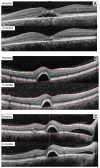Pilot study of oral administration of a curcumin-phospholipid formulation for treatment of central serous chorioretinopathy
- PMID: 22701080
- PMCID: PMC3373230
- DOI: 10.2147/OPTH.S31859
Pilot study of oral administration of a curcumin-phospholipid formulation for treatment of central serous chorioretinopathy
Abstract
Background: The purpose of this open-label study was to investigate the effect of a curcumin-phospholipid (lecithin, Meriva(®)) formulation (Norflo(®) tablet) on visual acuity and retinal thickness in patients with acute or chronic central serous chorioretinopathy.
Methods: Visual acuity was assessed by ophthalmologic evaluation, and optical coherence tomography was used to measure retinal thickness. Norflo tablets were administered twice a day to patients affected by central serous chorioretinopathy. The study included 18 eyes from 12 patients who completed a 6-month follow-up period. Visual acuity before and after Norflo treatment was the primary endpoint. The secondary endpoints were neuroretinal or pigment epithelial detachment, as measured by optical coherence tomography.
Results: After 6 months of therapy, 0% of eyes showed reduction in visual acuity, 39% showed stabilization, and 61% showed improvement. The improvement was statistically significant (P = 0.08). After 6 months of therapy, 78% of eyes showed reduction of neuroretinal or retinal pigment epithelium detachment, 11% showed stabilization, and 11% showed an increase.
Conclusion: Our results, albeit preliminary, show that curcumin administered as Norflo tablets is efficacious for the management of central serous chorioretinopathy, a relapsing eye disease, and suggest that bioavailable curcumin is worth considering as a therapeutic agent for the management of inflammatory and degenerative eye conditions, including those that activate the retinal microglia.
Keywords: Meriva®; Norflo®; central serous chorioretinopathy; curcumin; retinal pigment epithelium detachment.
Figures



Similar articles
-
Oral administration of a curcumin-phospholipid delivery system for the treatment of central serous chorioretinopathy: a 12-month follow-up study.Clin Ophthalmol. 2013;7:939-45. doi: 10.2147/OPTH.S45820. Epub 2013 May 22. Clin Ophthalmol. 2013. PMID: 23723686 Free PMC article.
-
Oral administration of a curcumin-phospholipid formulation (Meriva®) for treatment of chronic diabetic macular edema: a pilot study.Eur Rev Med Pharmacol Sci. 2018 Jun;22(11):3617-3625. doi: 10.26355/eurrev_201806_15189. Eur Rev Med Pharmacol Sci. 2018. PMID: 29917217 Clinical Trial.
-
Detection of morphologic alterations by spectral-domain optical coherence tomography before and after half-dose verteporfin photodynamic therapy in chronic central serous chorioretinopathy.Retina. 2011 Oct;31(9):1912-20. doi: 10.1097/IAE.0b013e3182252aa8. Retina. 2011. PMID: 21952105
-
Half-Fluence Photodynamic Therapy for Chronic Central Serous Chorioretinopathy: Predisposing Factors for Visual Acuity Outcomes.Semin Ophthalmol. 2018;33(5):690-699. doi: 10.1080/08820538.2017.1416414. Epub 2017 Dec 18. Semin Ophthalmol. 2018. PMID: 29252091
-
The Genetic Background of Central Serous Chorioretinopathy: A Review on Central Serous Chorioretinopathy Genes.J Genomics. 2021 Jan 1;9:10-19. doi: 10.7150/jgen.55545. eCollection 2021. J Genomics. 2021. PMID: 33456587 Free PMC article. Review.
Cited by
-
Comparative evaluation of the pain-relieving properties of a lecithinized formulation of curcumin (Meriva(®)), nimesulide, and acetaminophen.J Pain Res. 2013;6:201-5. doi: 10.2147/JPR.S42184. Epub 2013 Mar 8. J Pain Res. 2013. PMID: 23526055 Free PMC article.
-
Safety and efficacy of an add-on therapy with curcumin phytosome and piperine and/or lipoic acid in subjects with a diagnosis of peripheral neuropathy treated with dexibuprofen.J Pain Res. 2013 Jul 3;6:497-503. doi: 10.2147/JPR.S48432. Print 2013. J Pain Res. 2013. PMID: 23861596 Free PMC article.
-
Reduction of delayed onset muscle soreness by a novel curcumin delivery system (Meriva®): a randomised, placebo-controlled trial.J Int Soc Sports Nutr. 2014 Jun 18;11:31. doi: 10.1186/1550-2783-11-31. eCollection 2014. J Int Soc Sports Nutr. 2014. PMID: 24982601 Free PMC article.
-
Oral administration of a curcumin-phospholipid delivery system for the treatment of central serous chorioretinopathy: a 12-month follow-up study.Clin Ophthalmol. 2013;7:939-45. doi: 10.2147/OPTH.S45820. Epub 2013 May 22. Clin Ophthalmol. 2013. PMID: 23723686 Free PMC article.
-
B-Cell Disorders and Curcumin.Integr Cancer Ther. 2017 Sep;16(3):255-257. doi: 10.1177/1534735415622013. Epub 2015 Dec 16. Integr Cancer Ther. 2017. PMID: 26674787 Free PMC article.
References
-
- Graefe AV. Uber centrale recidivierende retinitis. Graefes Arch Clin Exp Ophthalmol. 1866;12:211–215. [German]
-
- Gass JD. Pathogenesis of disciform detachment of the neuroepithelium. Am J Ophthalmol. 1967;63(Suppl 3):1–139. - PubMed
-
- Mohan R, Sivak J, Ashton P, et al. Curcuminoids inhibit the angiogenic response stimulated by fibroblast growth factor-2, including expression of matrix metalloproteinase gelatinase B. J Biol Chem. 2000;275(14):10405–10412. - PubMed
-
- Chen M, Hu DN, Pan Z, Lu CW, Xue CY, Aass I. Curcumin protects against hyperosmoticity-induced IL-1 beta elevation in human corneal epithelial cell via MAPK pathways. Exp Eye Res. 2010;90(3):437–443. - PubMed
-
- Bengmark S. Curcumin, an atoxic antioxidant and natural NF kappaB, cyclooxygenase-2, lipooxygenase, and inducible nitric oxide synthase inhibitor: a shield against acute and chronic diseases. JPEN J Parenter Enteral Nutr. 2006;30(1):45–51. - PubMed
LinkOut - more resources
Full Text Sources

